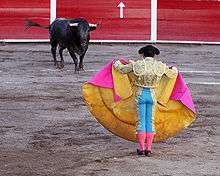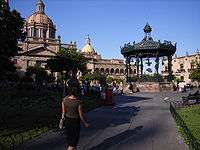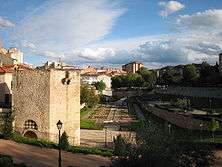Spaniards in Mexico
| Total population | |
|---|---|
| 123,189 Spanish nationals (2016)[1]Note | |
| Languages | |
| |
| Religion | |
|
Predominantly Roman Catholicism, also Sephardic Judaism | |
| Related ethnic groups | |
| Mestizo Mexican, other Spanish diaspora | |
|
^ Note: 19,223 individuals were born in Spain, 100,067 in Mexico, 3,689 in other countries and 210 were n/a. |
| Part of a series on |
| Spaniards |
|---|
| Regional groups |
Other groups |
| Diaspora |
| Languages |
|
Other languages
|
| Religion |
|
|
Spanish Mexicans are citizens or residents of Mexico who identify as Spanish as a result of nationality or ancestry. Spanish immigration to Mexico began in the early 1500s and spans to the present day.[2] There are three recognized large-scale Spanish immigration waves to Mexico: the first arrived during the colonial period, the second during the Porfiriato, the third after Spanish Civil War and the fourth (and current) after the 2008 financial crisis.
The first Spanish settlement was established in February 1519, as a result of the landing of Hernán Cortés in the Yucatan Peninsula, accompanied by about 11 ships, 500 men, 13 horses and a small number of cannons.[3] In March 1519, Cortés formally claimed the land for the Spanish crown, and the conquest of the Aztec Empire, a key event in the Spanish conquest of modern-day Mexico in general, was completed in 1521.
Arrival of the Spanish

The social composition of this immigration of the late sixteenth century included both common people, illiterates, and aristocrats with titles of counts and marquises, all of which quickly disintegrated over the territory. The discovery of new deposits of various minerals in the central and northern areas (from Sonora to the southern provinces of Mexico) allowed New Spain to gradually occupy a privileged position, especially in the extraction of silver. Mining allowed the development of associated activities such as manufacturing and agriculture, that turned the Bajío regions or the valleys of Mexico and Puebla into prosperous agricultural regions with incipient industrial activity.
In the 16th century, following the military conquest of most of the new continent, perhaps 240,000 Spaniards entered American ports. They were joined by 450,000 in the next century.[4] Since the conquest of Mexico, this region became the principal destination of Spanish colonial settlers in the 16th century. The first Spaniards who arrived in Mexico were soldiers and sailors from Extremadura, Andalucía and La Mancha after the conquest of America.[5][6] At the end of the 16th century both commoner and aristocrat from Spain were migrating to Mexico.
History
After of the independence of Mexico, a racism emerged against Spanish people in this new nation; in August 1827 to 1834, by decree issued during the government of Lorenzo de Zavala, that expulsed many Spaniards from State of Mexico and killed Spanish families. The state government, influenced by English masons or Yorkers, based on the Plan of Iguala and Treaty of Córdoba, stripped Spaniards of their haciendas, farms, ranches and properties in this state, leading many widows and orphans fled to other Mexican states.[7][8]
In December 20, 1827, was repealed the law Spanish expulsion by state deputies, many Creole families who were in misery, some returned to their farms and ranches protected by state congress deputies.[9] In the constitution of 1857, the ambiguities about Mexican citizens are removed, the Spaniards were recognized foreign people, they no longer recovered the important position during the colonial period.[10]
In the period 1850-1950, 3.5 million Spanish left for the Americas, and Mexico became one of the chief destinations, in 1876 Mexico establishes relationships with Spain; a second wave was particularly in the Northern region where president Porfirio Diaz started a campaign of European immigration to supply labor.[11] En 1910, there were 30,000 Spaniards in Mexico, they participated in economic activities as agricultural labors and trade in urban areas, they could not influence the country's political life.[12]
Most recent migrants came during the Spanish Civil War. More than 25,000 Spanish refugees settled in Mexico between 1939 and 1942, largely during the administration of President Lazaro Cardenas del Río. Some of the migrants returned to Spain after the civil war, but many more remained in Mexico.[13]
The Children of Morelia was formed in 1937 by 456 Spanish children, Republican's sons, which were brought from Spain in the vapor ship with French flag named Mexique, at the request of the Mexican Assistance Committee by Pueblo Spanish, based in Barcelona city. This children were received by Mexican President Lázaro Cardenas del Río.
Of these refugees is named as soon as "intellectual immigration" or "elite" was made up of approximately 25% of the total. It also notes that also came in greater numbers "factory workers and peasants" as well as soldiers, sailors and pilots, statesmen, economists and businessmen, all linked to the Republican government defeated in war.[14]
Due to the 2008 Financial Crisis and the resulting economic decline and high unemployment in Spain, many Spaniards have been emigrating to Mexico to seek new opportunities.[15] For example, during the last quarter of 2012, a number of 7,630 work permits were granted to Spaniards.[16]
Discrimination and stereotypes
The word gachupín is used for Spaniards who lives in Mexico and Guatemala,[17] is offence word in Mexico with relation as conquistadors and people of Spain.[18] Official history says; when Miguel Hidalgo y Costilla was mentioned in the Grito de Dolores; Mueran los gachupines, (Death the gachupines!).[19][20]
Diego Rivera was a Mexican pinter, who caused controversy with their mural named La leyenda negra de la Conquista (The black leyend of Conquest), panted between 1929 and 1930, he was accused of Hispanophobia creating diplomatic conflicts between Mexican government with Spanish government.[21]
The stereotypes about Spaniards in Mexico are men with barb and boina, people smoking habanos and drinking wine, many newspaper's cartoons describes this images for gachupines or Spanish people.
Spanish culture in Mexico

Languages
Spanish was brought to Mexico around 500 years ago. As a result of Mexico City's central role in the colonial administration of New Spain, the population of the city included relatively large numbers of speakers from Spain. Mexico City (Tenochtitlán) had also been the capital of the Aztec Empire, and many speakers of the Aztec language Nahuatl continued to live there and in the surrounding region, outnumbering the Spanish-speakers for several generations. Consequently, Mexico City tended historically to exercise a standardizing effect over the entire country, more or less, evolving into a distinctive dialect of Spanish which incorporated a significant number of Hispanicized Nahuatl words.
During the Spanish Exile, the Catalan language was expressed by writers and poets in Mexico, the Orfeó Català de Mèxic was a mecca for Catalan speakers and artists.[22][23]
Charreria
Charreria, a word encompassing all aspects of the art, evolved from the traditions that came to Mexico from Salamanca, Spain in the 16th century. When the Spanish first settled in Colonial Mexico, they were under orders to raise horses named criollos (Spanish Creole people), but not to allow Native Americans to ride. However, by 1528 the Spanish had very large cattle-raising estates and found it necessary to employ indigenous people as vaqueros or Criole herdsman, who soon became excellent horsemen. Smaller landholders, known as rancheros or ranchers, were the first genuine charros and they are credited as the inventors of the charreada.[24]
Bullfighting
Bullfighting arrived in Mexico with the first Spaniards and the rest of Latin America in the 16th century. Records are found of the first bullfights debuted in Mexico on June 26, 1526, with a bullfight in Mexico City held in honor of explorer Hernán Cortés, who had just come back from Honduras (then known as Las Hibueras). From that point on, bullfights were staged all over Mexico as part of various civic, social and religious celebrations. Today, there are about 220 permanent bullrings throughout Mexico with the largest venue of its kind is the Plaza de toros México in central Mexico City which opened in 1946 and seats 48,000 people.[25]
Holy week
Holy week is a Spanish tradition represented in many Mexican cities as San Luis Potosí City, Taxco de Alarcón or Morelia, this religious representation is very similar to Sevilla Holy week prossetion o Semana Mayor from other Spanish cities..
Spanish place names in Mexico
There are hundreds of places in Mexico named after places in Spain or have Spanish names due to the Spanish colonialism, Spanish settlers and explorers. These include:
- Guadalajara, Jalisco, after Guadalajara, Spain,
- Mérida, Yucatán after Mérida, Spain
- Zamora, Michoacán after Zamora, Spain
- León, Guanajuato after León, Spain
- Valladolid, Yucatán after Valladolid, Spain and Morelia, Michoacán formerly named Valladolid de Michoacán
- Nuevo León named after the former Kingdom of León in Spain
- Monterrey city was named after the Countess of Monterrei (a city in Galicia, Spain), wife of the Viceroy of New Spain Gaspar de Zúñiga, 5th Count of Monterrey, Count of Monterrey, Spain.
- Salamanca, Guanajuato named after Salamanca, Spain
- Burgos, Tamaulipas named after Burgos, Spain
- Linares, Nuevo León named after Linares, Spain
- Durango, Durango named after Durango, Spain
- Nuevo Laredo, Tamaulipas after Laredo, Cantabria, Spain
- Córdoba, Veracruz after Córdoba, Spain
- Zaragoza, Veracruz after Zaragoza, Spain
- Zaragoza, Puebla after Zaragoza, Spain
- Medellín, Veracruz after Medellín, Spain
- Puebla de Zaragoza after Puebla de Sanabria
- Compostela, Nayarit after Santiago de Compostela
- Villahermosa, Tabasco after Villahermosa del Campo, Spain
- Reynosa, Tamaulipas after Reinosa, Cantabria, Spain
- Madrid, Colima after Madrid, Spain
- Matamoros, Tamaulipas after Valle de Matamoros, Extremadura, Spain
- Altamira, Tamaulipas after Altamira, Bilbao, Spain
- Arandas, Jalisco after Aranda, Aragón, Spain
- Arandas, Guanajuato after Aranda, Aragón, Spain
- Guadalcázar, San Luis Potosí after Guadalcázar, Córdoba, Spain
- Lerma, State of Mexico after Lerma, Castile and León, Spain
- Lerma, Campeche after Lerma, Castile and León, Spain
- Candelaria, Campeche after Candelaria, Tenerife Canary Islands, Spain
- Granada, Yucatán after Granada, Andalusia, Spain
Communities
The Asturians are a very large community that have a long history in Mexico, dating from colonial times to the present.[26] There are about 42,000 people of Asturian birth in Mexico. The Catalans are also very numerous in Mexico. According to sources from the Catalan community, there are approximately 12,000 Catalan-born around the country.. There are also as many as 8,500 Basques, 6,000 Galicians, and 1,600 Canary Islanders.
Regions
The largest population of Spanish descent are located in the Northern region, where they make up the largest proportion of the population. Large populations are found in the states like Sinaloa, Jalisco, Zacatecas, Aguascalientes, Durango, Guanajuato, Mexico City, Puebla, and Veracruz. Also, Northern Mexico is inhabited by many millions of Spanish descendants. Some states like Zacatecas, Sinaloa, Chihuahua, Sonora, Nuevo Leon and Tamaulipas, have those of Spanish descent as the majority of the population.
As the Spanish royal Government doted the New Spain from Kingdoms and Territories, a great part of them followed names. So we can find lots of Basque criollos in Durango and Southern Chihuahua as those territories were part of the Kingdom of New Vizcay, Galician descendants in Jalisco being part of the Kingdom of New Galicia.
Numbers
Spanish descendants make up the largest group of Europeans in Mexico and a majority of Mexicans have some degree of Spanish descent. Most of their ancestors arrived during the colonial period but a further hundreds of thousands have since then immigrated, especially during the Spanish Civil War in the 1930s.[27] According to CIA World Factbook, whites make up 10% of Mexico's population.[28] The Encyclopædia Britannica states those of predominantly European descent make up closer to one-sixth (≈17%) of the Mexican population.[29]
| Spaniards in Mexico | ||||
|---|---|---|---|---|
| Year | Residents | |||
| 2010 | 77,069 (INE)[30] | |||
| 2011 | 86,658 (INE)[31] | |||
| 2014 | 108,314 (INE)[32] | |||
| 2015 | 115,620 (INE)[33] | |||
See also
- Basque Mexicans
- Galician Mexicans
- Catalan Mexicans
- Asturian Mexicans
- Mexico–Spain relations
- Immigration to Mexico
- Mexicans of European descent
References
- ↑ "Estadística del Padrón de Españoles Residentes en el Extranjero a 1 de enero de 2016" (PDF). Instituto Nacional de Estadística. Retrieved 18 March 2016.
- ↑ http://www.britannica.com/EBchecked/topic/379167/Mexico/27384/Ethnic-groups
- ↑ Bernard Grunberg, "La folle aventure d'Hernán Cortés", in L'Histoire n°322, July–August 2007
- ↑ Axtell, James (September–October 1991). "The Columbian Mosaic in Colonial America". Humanities. 12 (5): 12–18. Archived from the original on May 17, 2008. Retrieved 2008-10-08.
- ↑ http://www.emperadores.es/circuitos/tierra-de-conquistadores
- ↑ http://www.allspainaccommodation.com/extremadura/extremadura.htm
- ↑ Estado de México, Textos de su historia, Institute Mora, Mexico State govement, Toluca, 1996. pp.227-230.
- ↑ Los españoles en el México Independiente Colegio de México, pps. 624-627
- ↑ Estado de México, Textos de su historia, Institute Mora, Mexico State govement, Toluca, 1996. pp.230.
- ↑ Los españoles en el México Independiente Colegio de México, pps. 620-622
- ↑ Patricia Rivas. "Reconocerán nacionalidad española a descendientes de exiliados :: YVKE Mundial". Radiomundial.com.ve. Retrieved 2010-07-10.
- ↑ Los españoles en el México Independiente Colegio de México, pps. 620-622
- ↑ Milenio noticias
- ↑ El Exilio español en la Ciudad de México.
- ↑ http://newamericamedia.org/2013/02/as-spains-economy-worsens-young-adults-flock-to-mexico-for-jobs.php
- ↑ http://www.forbes.com/sites/nathanielparishflannery/2013/04/30/as-spain-falters-spaniards-look-to-latin-america/
- ↑ Gachupín The free dictionary.
- ↑ La voz de Galicia
- ↑ Grito de Dolores Zocalo Saltillo.
- ↑ Capsulas de lengua, Gachupines
- ↑ La utopia de forjar una sola raza para la nación, González Salinas, Omar Fabián, Historia Y MEMORIA magazine, 2016, number 13, page 320, Tunja, Colombia.
- ↑ Universitat de Barcelona Els Jocs Florals de la Llengua Catalana a l'exili (1941-1977).
- ↑ Orfeó Català de Mèxic
- ↑ http://dnn.epcc.edu/nwlibrary/borderlands/10_la_charreada.htm
- ↑ www.worldstadiums.com
- ↑ Economía UNAM Los asturianos y la modernización commercial de México y España en el siglo XX, 2005.
- ↑ http://news.newamericamedia.org/news/view_article.html?article_id=083e0b4728d31cd23a57533cf02c46c5
- ↑ CIA World Factbook. See also White Latin American for external sources.
- ↑ http://www.britannica.com/EBchecked/topic/379167/Mexico/27384/Ethnic-groups?anchor=ref394520
- ↑ Inmigrantes españoles INE 2010.
- ↑ Inmigrantes españoles INE 2011.
- ↑ Inmigrantes españoles INE 2014.
- ↑ Inmigrantes españoles INE 2015.
External links
- How the Spanish Civil War Drove My Family to Mexico
- Los que llegaron, Españoles
- Los niños de Morelia
- Romería del Pilar in Parque España, Puebla City.

